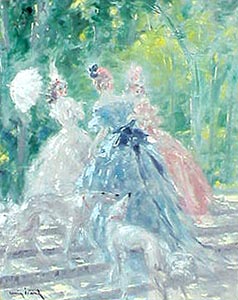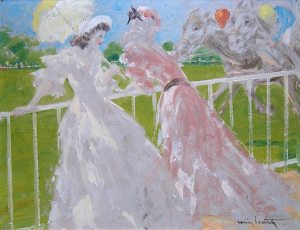If I post an entry every Monday to Friday, I’ve got to come up with over 250 posts per year, so I need ideas. Please suggest some to me. This one comes from my daughter, Nicole. She asked me to answer questions that are commonly asked of me at shows. I was asked this question on Sunday at the Redondo Beach Antiques Fair. “How can you tell an etching is authentic?”

Louis Icart pulling a proof of Joy of Life from the etching press
First you have to understand the process of producing an etching. The artist does his work on a copper plate, so the “original” is a copper plate and that’s rarely ever for sale. To produce the image, first the plate is hand-inked. Then the paper is laid down on top and the two pass together through the etching press, under tremendous pressure. The pressure transfers the image to the paper. Since the copper plate has thickness, it “dents” the paper around the edge of the image. This “dent” is called a plate impression. You can see it and feel it around the edge of the plate. So #1. A real etching has a plate impression.
Since the process is not photographic and there is no printing press, there are no dots in the image. If you use a magnifying glass to look at a photograph in a newspaper, you can see the entire image is made up of dots. Use a magnifying glass with an original etching and there are no dots. So #2. An authentic etching does not have any dots in the image.
After the edition is printed by the master printer, it is given back to the artist to hand-sign each one. Prints or other fakes have copies of the signature. So #3. Authentic etchings are hand-signed by the artist, usually in pencil.
In the case of Louis Icart, a raised seal called a blindstamp, was created in mid-1926, and is usually found in the lower left corner, just below the image. Most Icart images produced after this time have the blindstamp, but don’t use this information as a crutch. There are some fake etchings that have fake blindstamps. And conversely, there are many authentic Icart etchings that do not have a blindstamp. Supposedly the etchings without blindstamps were not for export from France, but personally I’ve found too many instances where this rule doesn’t seem to follow.
If you like my blog, please recommend it to others. Email me with your comments and suggestions. philchasen@gmail.com



